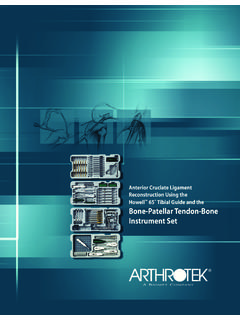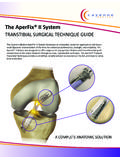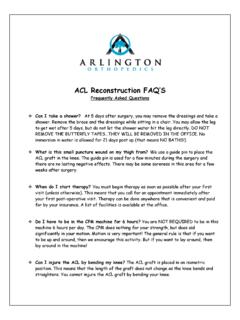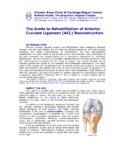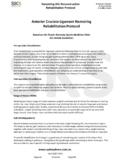Transcription of ACL RECONSTRUCTION POST-OPERATIVE …
1 ACL RECONSTRUCTION POST-OPERATIVE rehabilitation programme ABOUT THE OPERATION The aim of your operation is to reconstruct the anterior cruciate ligament (ACL) to restore knee joint stability. A graft, consisting of your hamstring tendon, is used to replace the damaged ligament . The graft is obtained via incisions at the front of your knee. The remainder of the surgery is done arthroscopically, which means that most of the surgery has been done inside the knee with the aid of a telescope-like instrument, and without actually opening/cutting the knee joint capsule. This results in less pain and scarring within the knee post -operatively and ultimately a quicker recovery. Because the hamstring tendon has been used for the graft it is normal for the hamstring to feel sore for up to 6 weeks post -op. If a synthetic graft (lars) is used this allows for a more accelerated rehabilitation program.
2 The graft is fed through a tunnel drilled into the tibia (shin bone), across the knee joint and then into the femur (thigh bone). The graft is fixed at each end with screws and is therefore initially very strong, allowing early movement and weight bearing on the leg. Because the ACL graft is a free graft with no blood vessels, time is needed for the graft to establish its own blood supply. The graft is strong immediately post -op, but loses strength during the first 6-8 weeks, and is at its weakest 6 weeks post -op. It is vulnerable at this time as the knee feels strong, but the graft is only beginning to establish its new blood supply. The graft does not have good blood supply until at least 10 weeks post -op. At 12 months post -op, the graft is 92% as strong as the original ACL, and this is as much strength as it develops.
3 AFTER THE OPERATION The main aim of the first 2 weeks is to keep swelling and pain to a minimum and to maintain some muscle tone and flexibility. This can be achieved in the following ways: Apply ice to the knee for 20 minutes after each set of exercises, 3-4 times per day. When applying ice, keep the leg in elevation. Sitting with your leg up on a stool is not adequate, you need to have the whole leg above the level of your heart. For example, lie on floor/bed with foot up on chair/pillows etc. There should be little or no pain associated with the exercises. Ease off on the exercises if they cause increased pain or swelling. Do not rest with a pillow crossways under your knee. It should rest completely straight. When to Wear Your Splint Only if your surgeon has indicated you need to wear a splint Only when walking for the first 2 weeks or until review with your surgeon.
4 Ambulation Use crutches and partially weight bear through operated knee for the first 2 weeks. Frequency of Exercises 3-4 times per day, unless otherwise indicated. IF YOU HAVE ANY DIFFICULTIES OR CONCERNS PLEASE CONTACT BODY LOGIC PHYSIOTHERAPY Pre & post operative rehabilitation is a major factor in the success of ACL RECONSTRUCTION . In the early weeks post op it is crucial to control the swelling, restore full joint movement and normalise walking patterns. rehabilitation after your surgery is an integral part of optimizing your return to full function and providing greater certainty of the best possible result from your surgery. Let Body Logic Physiotherapy help you achieve your goals. Contact our reception to make an appointment Body Logic Physiotherapy Bethesda Hospital 25 Queenslea Drive Claremont WA 6010 Tel: (08) 9230 6310 ACL RECONSTRUCTION FUNCTIONAL ACTIVITIES TIMELINE Please be aware that this timeline is a guide only.
5 Everybody s rate of healing differs and you may progress faster or slower than indicated. Please feel free to call us at Body Logic Physiotherapy if you feel you are not progressing as well as you should be. 0-2 weeks: Weight bearing as tolerated. Begin walking with use of the crutches, easing off them as your pain allows Stationary bike riding as soon as able with no resistance. Begin doing only 10 minutes at a time, increasing time to 20 minutes. Ice your knee before and after. If your surgeon has asked you to wear a splint do not bike See your physiotherapist at 2 weeks after your knee RECONSTRUCTION . 2-6 weeks: Begin aquatic physiotherapy program designed for you by your physiotherapist. Keep up with your rehab program as indicated by your physiotherapist. Gently increase the resistance on the stationary bike as your pain allows. 6-12 weeks: At 6 weeks begin swimming, use a pool buoy in between your legs and do not kick.
6 This will begin to improve your cardiovascular fitness and upper body strength. At 10 weeks commence swimming with a light kick. Commence riding on the road at 8 weeks. Commence jogging in straight lines on the flat at 10 weeks. Start with only 1km a day. Increase very gradually if no increase in pain or swelling. 12 weeks to 5 months: Strength and agility exercises will progress Low impact step aerobics classes can be commenced as indicated by your physiotherapist. Commence sport specific activities guided by your physiotherapist. 5-6 months: Return to training and participating in skill exercises. Follow your physiotherapist s guidelines for return to sport modifications. Train in PEP program for warm up to reduce further ACL injury. ACL RECONSTRUCTION EXERCISES (Exercises to be done 3 times per day) Stage 1 (0-2 weeks): Goals: 1. Control Swelling REST ICE 15 to 20 minutes, 4 times per day COMPRESSION Wear tubigrip during the day ELEVATE rest as frequently as you can with your leg up on a bed/couch 2.
7 Mobility Achieve correct gait, FWB. If pain allows without crutches 3. Exercises Achieve full passive extension (straighten out flat) Achieve full flexion (bending of the knee) may be limited by swelling Active strengthening begins with static weight bearing co-contractions of quadriceps and hamstrings (emphasising VMO) and progresses to active free hamstring contractions by day 14. Ankle Exercises Move foot up and down and around in circles. Repeat 10 times in Each direction every hour, for the first few days. Calf Stretch Use towel or belt around foot to pull toes towards face. Hold for 20 seconds, relax, repeat 3 times. Hamstring Stretch Keeping knee and back straight, lean forward until you feel a gentle Stretch behind the knee. Hold for 20 seconds, relax, repeat 3 times. Quad Sets/Extension 1. Sit or lie on your back with your leg straight.
8 2. Press the back of your knee downwards by tightening the muscle on the front of your thigh. 3. Hold for 5 seconds. 4. Repeat 3 x 10 times. Isometric Quadriceps/Hamstring Co-Contraction (long sitting position) 1. Sit with a rolled up towel under your knee and the thigh rolled outwards. 2. Dig heel into bed and tighten whole thigh. 3. Place fingers on inner thigh just above kneecap to feel quadriceps/Vastis medialis muscle contracting. 4. Hold contraction for 5 secs, rest for a few seconds. 5. Repeat 3 x 10 times. 6. You can also do this sitting Bent Leg Raise 1. With knee bent to about 30 degrees, lift leg off bed. 2. Keep your knee flexed at 30 throughout the exercise. 3. Hold for 5 seconds, then relax. 4. Repeat 3 x 10 times. FLEXION EXERCISES Passive Flexion in Sitting Commence now. 1. Wrap a towel around the ball of your foot of your operated leg.
9 2. Holding the ends of the towel in your hands, gently pull the ends of the towel so that your knee bends with it. 3. Hold at the comfortable limit of flexion for 5 seconds. 4. Continue slowly 10 times. Gradually increase to 30 times. Passive Flexion in Prone Commence in 1-2 days. 1. Lie on stomach. 2. Place foot of unoperated leg underneath shin of operated leg. 3. Gently assist the injured leg to bend as far as comfortable by pushing up with the unoperated leg. 4. Hold at the limit of flexion for 5 seconds. 5. Continue slowly for 10 30 times. 6. Continue to do Passive Flexion in Sitting exercise before this one. (A) EXTENSION EXERCISES Supine Hangs Commence now. 1. Sit or lie with foot up on a ball/bolster/rolled towel. 2. Relax knee in straight position for 30 seconds. 3. Continue for a total of 5 minutes. Prone Hangs Commence in 1-2 days.
10 ** Only do this extension exercise. Stop doing the Supine Hangs** 1. Lie on stomach with knee-caps over the edge of a firm bench or bed. 2. Let operated knee gently hang over the end of bench/bed. 3. Hang for 1 minute, lift slightly up with good leg to rest for 30 seconds. 4. Continue for a total of 5 minutes. Advanced Prone Hangs Commence in 5-7 days. ** Only do this extension exercise. Stop doing the Prone Hangs** 1. Lie on stomach with knee-caps over the edge of bench or bed. 2. Let operated knee gently hang over the end of bench/bed. 3. Rest the foot of your good leg over the ankle of your operated leg, to gain a greater stretch. 4. Hold position for 1 minute, then ease pressure off by lifting good leg off for 30 seconds. 5. Continue for a total of 5 minutes. Patella Mobilisation With knee straight and relaxed, gently move kneecap from side to side (A) and up and down (B).


